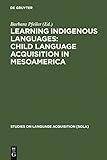Learning Indigenous Languages: Child Language Acquisition in Mesoamerica / ed. by Barbara Pfeiler.
Material type: TextSeries: Studies on Language Acquisition [SOLA] ; 33Publisher: Berlin ; Boston : De Gruyter Mouton, [2011]Copyright date: ©2007Description: 1 online resource (209 p.) : Num. figs. and illContent type:
TextSeries: Studies on Language Acquisition [SOLA] ; 33Publisher: Berlin ; Boston : De Gruyter Mouton, [2011]Copyright date: ©2007Description: 1 online resource (209 p.) : Num. figs. and illContent type: - 9783110195590
- 9783110923148
- 401.93
- P118 .L38986 2007
- online - DeGruyter
- Issued also in print.
| Item type | Current library | Call number | URL | Status | Notes | Barcode | |
|---|---|---|---|---|---|---|---|
 eBook
eBook
|
Biblioteca "Angelicum" Pont. Univ. S.Tommaso d'Aquino Nuvola online | online - DeGruyter (Browse shelf(Opens below)) | Online access | Not for loan (Accesso limitato) | Accesso per gli utenti autorizzati / Access for authorized users | (dgr)9783110923148 |
Browsing Biblioteca "Angelicum" Pont. Univ. S.Tommaso d'Aquino shelves, Shelving location: Nuvola online Close shelf browser (Hides shelf browser)

|

|

|

|

|

|

|
||
| online - DeGruyter The Vitality of Enjoyment in Qohelet's Theological Rhetoric / | online - DeGruyter Nietzsche und die historisch-kritische Philologie / | online - DeGruyter Europäische Insolvenzverordnung : Kommentar / | online - DeGruyter Learning Indigenous Languages: Child Language Acquisition in Mesoamerica / | online - DeGruyter Royal Autobiography in the Book of Qoheleth / | online - DeGruyter Die Umsetzung der Übernahmerichtlinie in Europa / | online - DeGruyter Hermann Hesse Bibliographie : Sekundärliteratur 1899-2007 / |
i-iv -- Contents -- Acknowledgements -- Introduction: The view from Mesoamerica -- Roots or Edges? Explaining variation in children’s early verb forms across five Mayan languages -- Explaining Ergativity -- Early acquisition of the Split Intransitive System in Yukatek -- A preliminary view at Ch’ol (Mayan) early lexicon: The role of language and cultural context -- Acquisition of referential and relational words in Huichol: from 16 to 24 months of age -- Culture-specific influences on semantic development: Learning the Tzeltal ‘benefactive’ construction -- Bcuaa quiang – I stepped HEAD it! The acquisition of Zapotec bodypart locatives -- “Lo oye, lo repite y lo piensa.” The contribution of prompting to the socialization and language acquisition in Yukatek Maya toddlers -- List of contributors -- Index
restricted access online access with authorization star
http://purl.org/coar/access_right/c_16ec
This book includes six studies on the acquisition of single Mesoamerican indigenous languages, (Huichol, Zapotec, and the Mayan languages Ch'ol, Tzeltal, K'iche', and Yukatek); and a crosslinguistic study of five Mayan languages (K'anjob'al, K'iche', Tzeltal, Tzotzil, and Yukatek). Three topics are theoretically and methodologically discussed and empirically demonstrated: with respect to ergativity, the ergative-absolutive cross-referencing pattern on the morphological level, noun-verb distinction and the acquisition of body-part locatives in the early lexicon, and the role of semantic properties and cultural context in language acquisition and socialization. This book makes important claims regarding the methodology of cross-linguistic studies as well as the results of these studies and the comparative method used in the book (structural and discursive factors in language acquisition, cross-linguistic relationships and variation).
Issued also in print.
Mode of access: Internet via World Wide Web.
In English.
Description based on online resource; title from PDF title page (publisher's Web site, viewed 28. Feb 2023)


